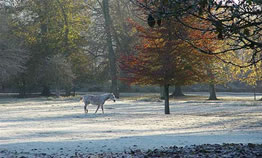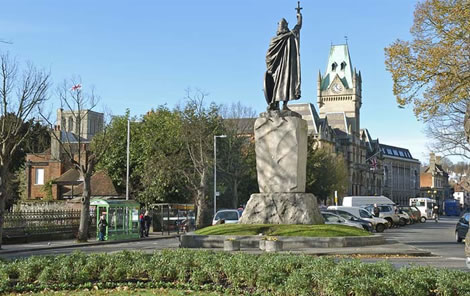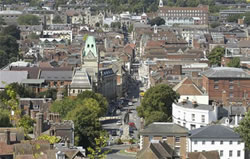





Above - Winchester High Street
Left - Winchester Broadway (Statue of King Alfred)

The weather lore surrounding St. Swithin's day is said to have arisen from the re internment of his body, on July 15th 971AD, from this grave outside of the Cathedral to a spectacular golden shrine within the Cathedral, having been interrupted by a very heavy rain storm.
This led to the folklore that if it rains on St. Swithin's Day (July 15th), it will rain for the next 40 days, and a fine day on the 15th July will be followed by 40 days of fine weather.
St. Swithin's day, if it does rain,
For forty days it will remain;
St. Swithin's day, if it be fair,
For forty days 'twill rain no more.
There is some degree of controversy about whether there is evidence to support the rhyme. As all the research I could find was statistical in nature, the statistics seem to have been manipulated to support the authors initial conjecture. However, in general terms the weather patterns that are establishing themselves around this time tend to persist and predominate for a good number of weeks.
Meteorologically speaking, the position of the frontal zone around the end of June to early July, indicated by the position of the jet stream, determines the general weather patterns (hot, cold, dry, wet) for the rest of the summer. The frontal zone tends to 'dig in' shortly after the summer solstice.
As the path of our weather systems is controlled by the jet stream, a more southerly location of the frontal zone is likely to bring rather unsettled, wet and cool weather. On the other hand, a frontal zone shifted further to the north will help the Azores high to build over western Europe, thus bringing dry and pleasant weather to the UK.Driest place (official records): Quillagua, Chile, 0.5mm average yearly rainfall
Lowest mean annual rainfall: 0.1mm Pacific coast of Chile
Most intense rainfall: 38.1mm in one minute, Barst, Guadeloupe, 26th November 1970
Most rainfall in one day: 1,870mm, La Réunion, Indian Ocean, 16th March 1952
Most rainfall in one year: 26,461mm, Cherrapunji, India, 1st August 1860 to 31st July 1861
Greatest average annual rainfall: 11,783mm, Mawsynram, Meghalaya State, India
Windiest place: sustained wind speeds of up to 320km/h throughout year, Commonwealth Bay, George V Coast, Antartica
Highest recorded wind speed: 371km/h, Mt Washington, New Hampshire, USA, 20th March 1986
Highest tornado wind speed: 512km/h, Oklahoma, 3rd May 1999
Highest recorded jet-stream speed: 656km/h, above South Uist, Outer Hebrides, Scotland, 13th December 1967
Lowest recorded temperature: -89.2°C, Vostok, Antartica, 21st July 1983
Lowest temperature for a permanently inhabited place: -68°C, Oymyakon, Siberia, 1933 (unofficial subsequent record -72°C)
Lowest mean annual temperature: -58°C, Polus Nedostupnosti (Pole of Inaccessibility), Antartica
Hottest mean annual temperature: 34°C, Dallol, Ethiopia
Highest recorded temperature: 58°C, Al'Azizyah, Libya, 13th September 1922
Greatest temperature rise: 27°C (-20°C to 7°C) in two minutes!, Spearfish, South Dakota, USA, 23rd January 1943
Greatest temperature drop in one day: -56°C (from 7°C to -49°C), Browning, Montana, USA, 23rd-24th January 1916
Greatest temperature range recorded: 105°C (from -68°C to 37°C), Verkhoyansk, Siberia
Greatest annual sunshine total: 4,300hrs (97% of total possible), Eastern Sahara
Lowest surface pressure: 870mb within typhoon Tip, west of Guam in the Pacific Ocean, 12th October 1979
Highest annual number of days with thunder: 322, Bogor, Java, Indonesia, between 1917 and 1919
Highest waterspout: 1,528m off Eden, New South Wales, Australia, 16th May 1898
Deepest clouds: 20km, cumulonimbus in tropics
Largest single hailstone: 1kg, Gopalganj, Bangladesh, 14th April 1986
Largest hailstone aggregates: 3.4kg, Hyderabad, India, 1939 and 4kg, Yüwu, China, 1902
Greatest daily snowfall: 1,930mm, Silver Lake, Colorado, USA, 14th-15th April 1921
Greatest single snowfall: 4,800mm, Mt Shasta Ski Bowl, California, USA, 13th-19th February 1959
Greatest depth of snow: 11,460mm, Tamarac, California, USA, March 1911
Greatest snowfall in one year: 31,102mm, Paradise, Mt Rainier, Washington, USA, 19th February 1971 to 18th February 1972